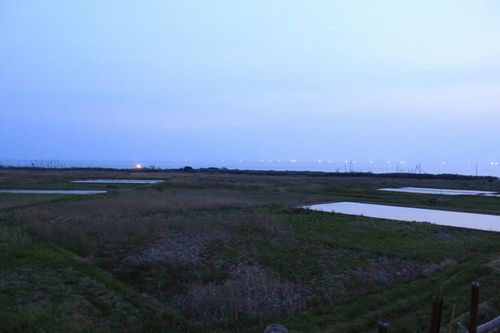November 26, 2014
Approaches Featuring Smart Agriculture Using Solar Power, Small Hydroelectric Plants Using Dam Wall to Vitalize Japanese Farm Villages
Keywords: Environmental Technology Local government Renewable Energy

Image by *sii Some Rights Reserved.
In Ishikawa Prefecture, Japan, renewable energy businesses have started to spread, particularly in agricultural villages and mountainous areas. Below we share a report about the efforts in the prefecture to introduce renewable energy businesses.
Editor's Note: This article is reproduced in edited form with permission from Smart Japan. Smart Japan is an online media services provider specializing in energy conservation, storage, and generation.
Hakui City with a population of 23,000 in Ishikawa Prefecture is an agricultural town with rice paddies occupying close to 40 percent of the whole area of the city. The city, however, has a problem that active rice farms have decreased in number, while abandoned rice paddies have increased. To tackle the situation, an initiative to introduce a business model incorporating solar power generation is underway, and this is expected to provide high levels of revenue.
There is a block of agricultural land in Hakui as large as 500,000 square meters, 90 percent of which is abandoned farmland. Using land rented from its owners, the project aims to revitalize the area by operating a solar power generation business using farm lands, along with striving for success in agricultural operations.
The solar power business can be profitable by selling surplus electricity. In other words, this project can be called a solar sharing project. Concerned parties have high expectations for the success of the project, as the project will be a good model to revitalize abandoned farmlands all across Japan, if successful.
Another approach in Ishikawa Prefecture is the Smart Agriculture System project now under development. The system targets greenhouse cultivation and will make it possible to keep temperature and lighting in greenhouses at the most appropriate levels using solar power generated and collected by applying a solar tracking system, which allows for highly efficient power generation.
Moreover, the Smart Agriculture System applies a thermoelectric generation system in combination with a solar power system. The coolant used in the solar tracking system is heated to generate vapor and the vapor generates power. The combined use of the two generation systems makes it possible to transform natural energies into electric energy with high efficiency.
The project will proceed with demonstrative operation of the systems applied to existing greenhouses to verify its effects. It is expected to reduce electricity expenses and increase harvests during an extended season.
Building Small Hydroelectric Plants to Make Use of Highest National Rainfall Levels
Ishikawa Prefecture has large mountainous areas in its southern regions and there exist many hydroelectric power plants. With the largest amount of annual precipitation in Japan, the prefecture is an appropriate area for hydroelectric power generation. Under the leadership of local governments, approaches to build small-scale hydroelectric generation plants using water streams such as agricultural waterways have started and are spreading.
One of the targeted facilities to be used for building a small hydroelectric plant is an erosion-control dam wall constructed in every region in the prefecture. The facility is intended to prevent damage from landslides. A project to build a small hydroelectric plant will start very soon at the Hirasagawa erosion-control dam wall, the largest wall of its kind in Ishikawa Prefecture.
The project plans to lay a water channel starting from the upstream side of the wall and reaching to the generator, which is installed at an underground site just below the wall, and to introduce water through the channel. The water head will be about 20 meters and the amount of water per second will peak at 1.5 cubic meters. Using this amount of water, 198 kilowatts of electricity is expected by adopting an S shape waterwheel, which allows efficient power generation with small amounts of water.
The project is scheduled to start operating the generator in February 2015. If the plant is able to operate 290 days a year, its annual electricity capacity will be about one million kWh. The profit from selling the electricity will be about 33 million yen (about U.S.$305,555), and the initial investment of 300 million yen (about U.S.$2.8 million) will be recovered in 15 years.
There has been little renewable energy introduced into Ishikawa prefecture to date. However, from now on, solar power generation is expected to spread in agricultural villages, and effective small-scale approaches will increase. It is hopeful that a new model of agriculture utilizing renewable energy will be born in Ishikawa Prefecture.
Source: Smart Japan (in Japanese)
Related
"JFS Newsletter"
- 'Yumekaze' Wind Turbine Project Connects Metro Consumers and Regional Producers: Seikatsu Club Consumers' Co-operative
- Shaping Japan's Energy toward 2050 Participating in the Round Table for Studying Energy Situations
- Nishiawakura's Initiative for 100% Energy Self-Sufficiency, and a Municipal ICO Scheme
- Actions Toward 100% Renewable Energy in Japan
- Sustainable Community Building in Shimokawa: Recycling-Oriented Forest Management Enabling Permanent Use of Forest Resources
Related
"Popular Articles"
- Current Status of Renewable Energy in Japan (2015)
- Offshore Wind Farm Withstands Great East Japan Earthquake and Tsunami
- Current Status of Renewable Energy in Japan (2014)
- Geothermal Power: Japan Has World's Third Largest Geothermal Reserves, 60 Percent of Which Can Be Developed
- Tokyo Plans to Increase Renewable Energy Ratio to 20% by 2024


